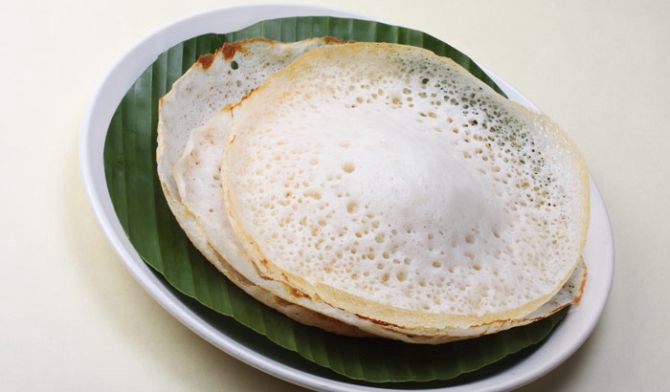Food in temples has always fascinated me and why not, it is especially prepared with best of the ingredients by priests and offered to the god, and the taste and bliss that you get after eating the food served at temples across the country is incomparable. Food offering plays a very integral role in the Indian belief system; the devotees honor the food in form of “Prasad” or mercy received by the lord. One such Prasad that is honored in south indian is deliscious Appams or sweet rice cakes.
The recipe of Appam can be dated right to the Vedic India, where Apupa a round cake of barley or rice flour was cooked in ghee on a slow flame and swttened with honey, this may have evolved to beome Appams in the Sangam Age. Apams are mentioned in Various of Tamil literatures. Appupa in the vedic age was a favouratie of the gods and also was main offering in various rituals. The cakes were shaped in form of tortoise, which resembled the second Incarnation of Lord Vishnu, Kurma Avatar. In this pastimes Lord balanced the Mandar Mountain and helped in churning of the Milk ocean. The Appam that is cooked today is cooked in a special appam pan, which has a cavity resembling tortoise.
These soft moist drak brown crispy crust rice balls are sweetend with jaggery are really most desirable culinary delight. . Traditionally it is cooked in a bronze pan called appakara, about eight inches in diameter, with three or more large cavities, similar to an aebleskiver pan. Neyyappam and adhirasam were popular temple offerings in South India by the eleventh century A.D, And the recipe remains unchanged , it was and is still made using mostly rice, jaggery and ghee . The flour may change depending to the temple, or the community of the maker. There are people who use maida (all-purpose flour) beaten rice (poha) and semolina.
Appam is prepared in temples of Ayyappa, ganapathi, Krishna and devi across south india. The sabrimala shrine dedicates to Ayyappa and Guruvayoorappan temple in Kerala serves best appams.
Appakkudathaan Perumal Temple is dedicated to Vishnu in Koviladi, Tamil Nadu. At this Vishnu temple, the belief is that when Vishnu disguised as an old man was offered a potful of appams by King Ubharisaravasu, the lord laid down there with the pot to enjoy them. The Lord here isknown as “Appakkudathaan” and “Appala Ranganathan”.
Appam is known by various names in south India. In Kerala – appam, unniappam (small appam), neyyappam (appam cooked in ghee), kuzhiappam (cooked in a kuzhi or cavity) Ganapathi appam, and koottappam (a pile of appams) are popular names. In Tamil Nadu appam is made by deep frying a fermented batter , whereas in south Karnataka it is called appe and it is a must for Ganesha puja. In Coorg in southwestern Karnataka it is called kajjaya. The Konkani community of Karnataka prepares it with semolina and either jackfruit or banana and call it Mulik. In Andhra Pradeh it is known as atrasalu and ariselu, and if it is deep fried in ghee it is called nethi ariselu. It is served at many auspicious occasions and at weddings.


